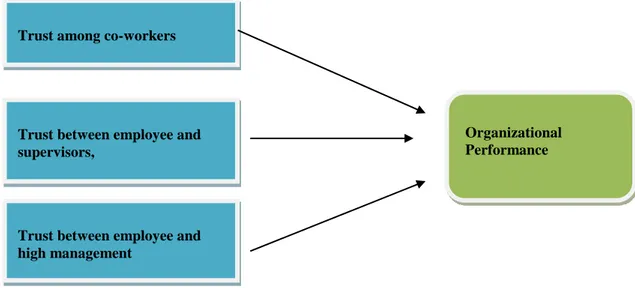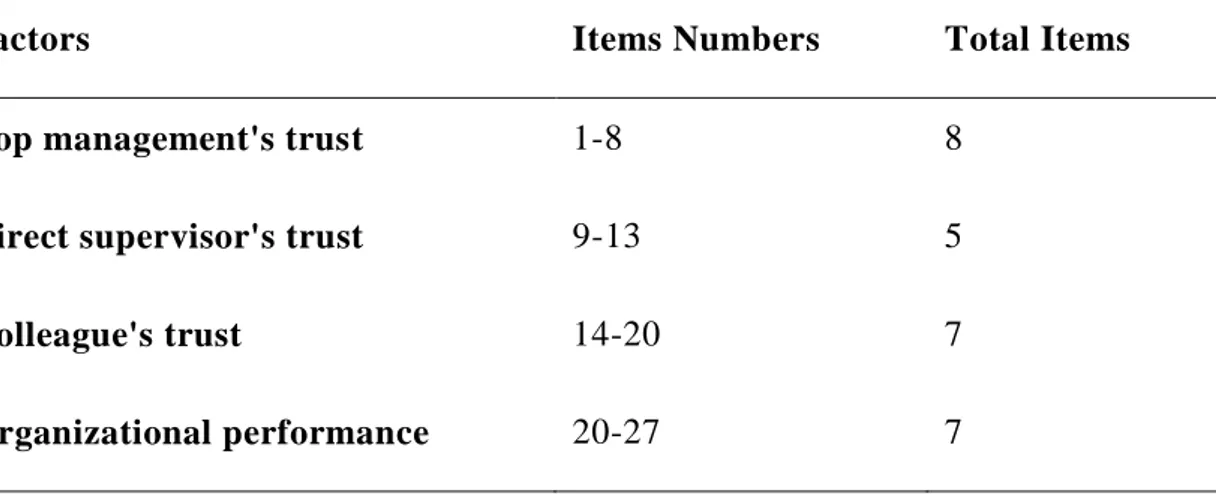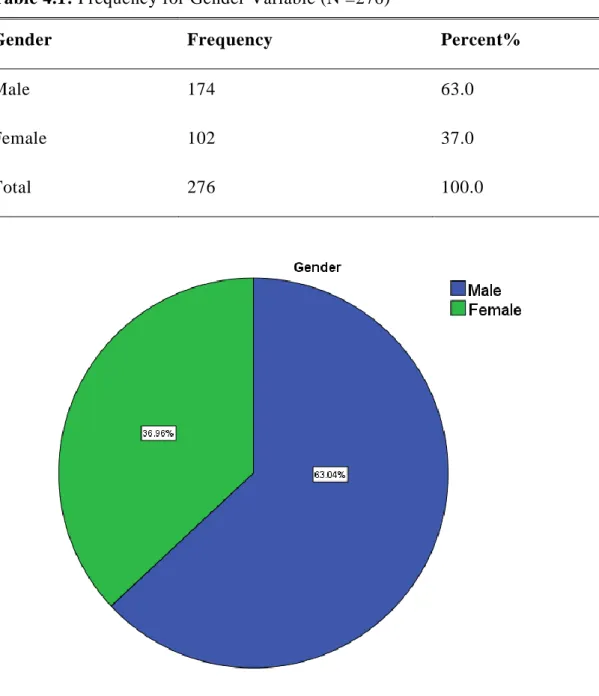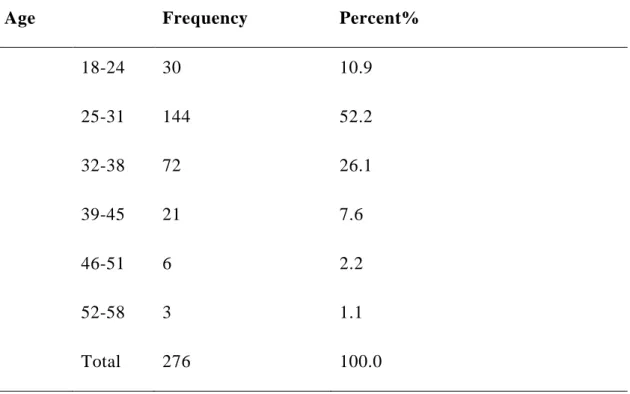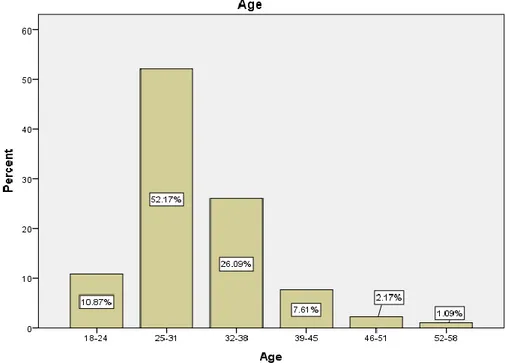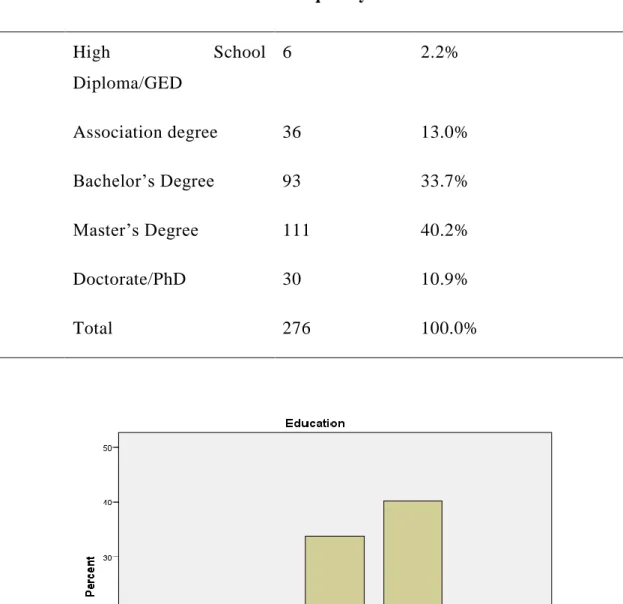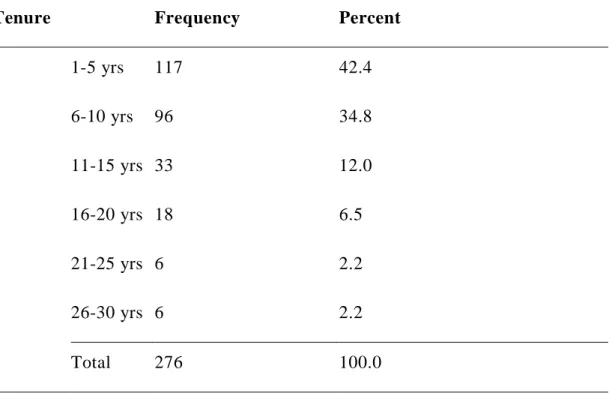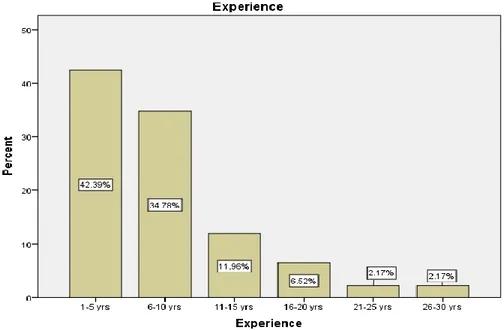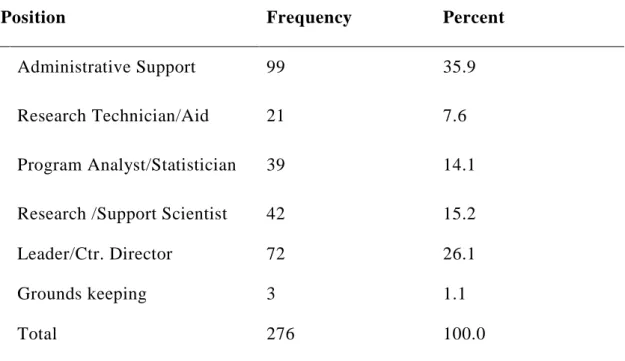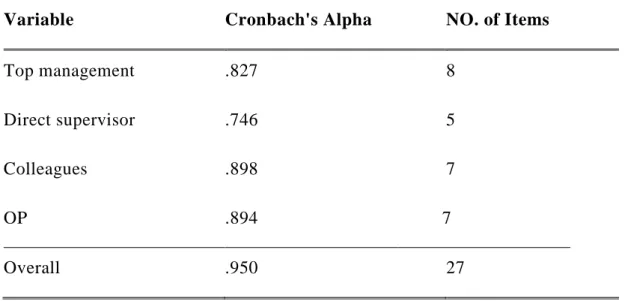T.C.
ISTANBUL AYDIN UNIVERSITY INSTITUTE OF SOCIAL SCIENCES
THE IMPACT OF TRUST AMONG STAFF ON THE ORGANIZATIONAL PERFORMANCE IN THE IT ORGANIZATIONS 2017-2018
THESIS
Ahmad Sameer Saeed ISSA
Department of Business Business Management Program
T.C.
ISTANBUL AYDIN UNIVERSITY INSTITUTE OF SOCIAL SCIENCES
THE IMPACT OF TRUST AMONG STAFF ON THE ORGANIZATIONAL PERFORMANCE IN THE IT ORGANIZATIONS 2017-2018
THESIS
Ahmad Sameer Saeed ISSA (Y1612.1300083)
Department of Business Business Management Program
Thesis Advisor: Ast. Prof. Dr. Burçin KAPLAN
DECLARATION
I hereby declare that all information in this thesis document has been obtained and presented in accordance with academic rules and ethical conduct. I also declare that, as required by these rules and conduct, I have fully cited and referenced all material and results, which are not original to this thesis.
FOREWORD
I have always looked forward to writing this section of my thesis since I started to my program at İstanbul Aydın University in 2017. Full of thanks and appreciations to my superviser Ast. Prof. Dr.Burçin KAPLAN as she was pationt and helpfull to guide in the research through her exp erience and scientific support, as well appreciations can‟t be enough to the pray of my mother and the great support and invistiment of my father to me, as they were the motive engine to complete this degree, and is not forgatble to thank all of my teachers in all educational levels, and to everyone helped me to my MBA degree.
July, 2019 Ahmad Sameer Saeed ISSA
TABLE OF CONTENT
Page
FOREWORD ... iv
TABLE OF CONTENT ... v
LIST OF FIGURES ... vii
LIST OF TABLES ... viii
ABSTRACT ... ix
ÖZET ... x
1. INTRODUCTION ... 1
1.1 Background Of The Study ... 1
1.2 Problem Statement ... 4
1.3 Objectives Of The Study ... 5
1.4 The Questions Of The Study ... 5
1.5 Research Hypotheses ... 6
1.6 Importance Of The Study ... 6
1.7 Theoretical Framework ... 7
Trust among co-workers ... 7
Organizational Performance ... 7
Trust between employee and supervisors, ... 7
Trust between employee and high management ... 7
1.8 The Study Organization ... 7
1.9 The Summary And Discussion ... 8
2. LITERATURE REVIEW ... 9
2.1 Introduction ... 9
2.2 Organizational Trust ... 11
3.2 The Importance Of Organizational Trust ... 13
2.4 Types Of Trust ... 14
2.5 The Dimensions Of Organizational Trust ... 16
2.5.1 Trust Between Co-worker ... 16
2.5.2 Trust Between Supervisors: ... 17
2.5.3 Trust in organization management: ... 17
2.6 Determinants Of Trust ... 18
2.7 Current Findings And Trends In The Trust Literature ... 18
2.8 Previous Studies ... 19
2.9 Conclusions ... 31
3..2 Summary ... 32
3. RESEARCH METHODOLOGY ... 34
3.1 Introduction ... 34
3.2 Research Method And Suitability ... 34
3.3 The Design Of The Research ... 35
3.4 The Setting Of The Research ... 35
3.5 The Questions Of The Research And The Design Of Hypotheses ... 36
3.7 Sample Standards And Sampling Techniques ... 37
3.8 Instruments ... 38
3.9 Data Collection ... 39
3.10 The Analysis Of Data ... 40
3.11 Research Summary ... 41
4. DATA ANALYSIS, RESULTS AND FINDINGS ... 43
4.1 Introduction ... 43
4.2 Summary Of Participation And Demographics... 43
4.3 Results Of The Study ... 50
4.4 Reliability Statistics ... 51
4.5 Levels Of Trust Among The Company Staff ... 51
4.6 Relationship Between Trust And Organizational Performance ... 55
4.7 Contributions Of Top Management‟s Trust, Direct Supervisors‟ Trust, And Colleagues‟ Trust ... 58
4.8 Checking The Assumptions ... 59
9.4 Evaluating The Model ... 61
4.10 Evaluating Each Of The Independent Variables ... 62
4.11 HYPOTHESES TESTING ... 63
4.12 Summary ... 65
5. CONCLUSIONS ... 66
5.1 Conclusions ... 66
5.2 Discussion ... 67
5.3 Implication Of The Study ... 68
5.4 Recommendations ... 68
5.5 Limitations Of The Study ... 69
5.6 Areas For Further Research ... 70
REFERENCES ... 71
APPENDIX ... 75
LIST OF FIGURES
Page
Figure 1.1: Framework of the Study ... 7
Figure 4.1:. Frequency for Gender Variable ...44
Figure 4.2: Frequency for age Variable ...46
Figure 4.3: Frequency for education variable ...47
Figure 4.4: Frequency for experience variable ...49
Figure 4.5: Frequency for position variable ...50
Figure 4.6: Normal Probability Plot (P-P) of the Regression Standardized Residual ..60
LIST OF TABLES
Page
Table 3.1: Distribution of items according to the different elements... 39
Table 4.1: Frequency for Gender Variable (N =276) ... 44
Table 4.2: Frequency for age Variable (N =276) ... 45
Table 4.3: Frequency for education Variable (N =276) ... 47
Table 4.4: Frequency for experience Variable (N =276) ... 48
Table 4.5: Frequency for position Variable (N =276) ... 50
Table 4.6: Reliability Statistics ... 51
Table 4.7: Means and Standard Deviations for Items of Top Managements' Trust .. 52
Table 4.8: Means and Standard Deviations for Items of Direct supervisors' Trust .. 53
Table 4.9: Means and Standard Deviations for Items of Colleague's Trust ... 54
Table 4.10: Means and Standard Deviations for Top Managements' Trust, Direct Supervisors' Trust and Colleagues' Trust ... 55
Table 4.11: Pearson correlation between level of Organization Trust and Organizational Performance ... 56
Table 4.12: Pearson correlation between level of Top Management's Trust and Organizational Performance ... 57
Table 4.13: Pearson correlation between level of Direct supervisor's Trust and Organizational Performance ... 57
Table 4.14: Pearson correlation between level of colleague's Trust and Organizational Performance ... 58
Table 4.15: Correlations between the study variables (n=276) ... 59
Table 4.16: Model Summaryb ... 61
Table 4.17: ANOVA test analysis ... 62
THE IMPACT OF TRUST AMONG STAFF ON THE ORGANIZATIONAL PERFORMANCE IN THE IT ORGANIZATIONS 2017-2018 .
ABSTRACT
Organizational trust is characterized by merit, good faith, transparency and experience, which in turn enhances the credibility of the company. Trust creates an opportunity to deal with the complexity and duties of businesses, which thus represents the amount of risk that one is willing to accept in exchange for benefiting from the interactions with others. The purpose of this study is the identification of the effect and relationship between the top management's trust, direct supervisor's trust, and colleague's trust as well as the organizational performance; which can create and lead to a sustainable competitive advantage. A quantitative approach was adopted in the research. This research was carried out and data were gathered at IBM Malaysia and Armada Inovasi in Cyberjaya City in Malaysia. Quantitative Survey Methodology was used to evaluate survey responses via the use of correlation tests. The research revealed a positive and strong correlation between the variables of trust and organizational performance; thus, the study shows that there is a large positive significant relationship between trust and organizational performance. It also shows that there are large positive significant relationships between top management, direct supervisors, and colleagues, and the organizational performance. The study revealed the findings of the multiple deviation for the whole model. The variation in the organizational performance was explained by the variables of trust. F-value attained a level of significance, and the general regression model was appropriately fit and good. The three variables of trust enjoyed by the staff of the investigated organization are a significant and positive indicator of organizational performance. Direct supervisor had a stronger contribution and is the only variable that attained a statistically significant level of organizational performance. This helps direct managers and supervisors to earn useful experiences that will help in productive and positive relations with the staff within organizations.
YABANCI DİL KAYGISININ ORTAOKUL ÖĞRENCİLERİ ÜZERİNDEKİ ETKİLERİ
ÖZET
Örgütsel güven liyakat, iyi niyet, şeffaflık ve deneyim ile karakterize edilir ki bu da şirketin güvenilirliğini artırır. Güven, işletmelerin karmaşıklığı ve görevleri ile başa çıkmak için bir fırsat yaratır, bu da kişinin başkalarıyla etkileşimlerden faydalanma karşılığında kabul etmeye istekli olduğu risk miktarını temsil eder. Bu çalışmanın amacı, üst yönetimin güveni, direk denetçi güveni ve iş arkadaşınızın güveni ile örgütsel performans arasındaki etki ve ilişkinin belirlenmesidir; sürdürülebilir bir rekabet avantajı ortamına yol açabilir. Araştırmada kantitatif bir yaklaşım benimsenmiştir. Yapılan araştımada veriler Malezya IBM ve Armada Inovasi Cyberjava şirketlerinden toplanmıştır. Kantitatif Anket Metodolojisi, korelasyon testleri kullanılarak anket yanıtlarını değerlendirmek için kullanılmıştır. Araştırma güven ve örgütsel performans değişkenleri arasında olumlu ve güçlü bir korelasyon olduğunu, böylece, güvenin ve örgütsel performans arasında önemli ve olumlu bir ilişkisi olduğunu göstermektedir. Ayrıca, üst yönetim, direk denetçiler ve iş arkadaşlarının organizasyonel performans arasında olumlu ve önemli ilişki bağı olduğunu gösterir. Çalışma, tüm model için çoklu sapma bulguları ortaya koymuştur. Organizasyonel performanstaki değişim güven değişkenleri ile açıklanmıştır. F-değeri önem düzeyine ulaştı ve genel regresyon modeli uygunluk gösterdi. Organizasyonda incelenen personelinin sahip olduğu üç değişik değişkenin doğrudan, organizasyonel performansın üzerinde etkisi olduğunu göstermektedir. Direk denetçinin organizasyonel performans düzeyine en fazla katkısı vardı ve istatistiksel olarak en anlamlı seviyeyi ulaşan tek değişkendir. Bu, doğrudan yöneticilerin ve denetçilerin, kuruluşlardaki personelle verimli ve olumlu ilişkiler de yardımcı olmalarına ve yararlı deneyimler kazanmalarına yardımcı olur.
1. INTRODUCTION
1.1 Background Of The Study
Many researchers and writers have been interested in the concept of trust. It has received attention in many scientific fields, especially in the field of organizational behavior, because of the diverse behaviors of individuals and groups and their mutual effects on the strategic performance of the organization, and that confidence helps to promote and develop cooperative behavio r and effective responses to problem solving. To illustrate the importance of confidence building and its impact on work outcomes within the organization, most studies have shown a positive and moral relationship between trust and performance and the behavior of organizational citizenship and creativity. Other studies have shown an inverse relationship between trust and turnover, absenteeism and conflict. The individual in the organization reduced turnover and conflict among individuals within the organization (Sabeeha, 2010).
Scholarly trust-related studies recently employed different techniques to explain different aspects of trust. Further, trust has the ability of resolving the risk that exists with individuals; and this is one of the reasons as to why t rust is referred to as an encouraging action for risk taking. The environment is one of the importance of trust, and this is the reason for its strengthening and reinforcement of the relationship that exists between organizations. In recent times, studies have shown the benefit of trust with regards to the well -being of persons, in the business environment. Further, trust is the key element for functional communication as well as cooperate task amongst colleagues; amidst employees and managers; as well as amongst managers and employees. Trust decreases the costs and risks of operation. It also increases the productivity of employees.
The current world attempts to creatively produce the best performance. the organizations try to develop their concepts and tools regardless the traditional devices or machines. Such organizations believe that the most important factors
for achieving such conceptions are the workers and employees. Further, the process of enriching the performance of requires certain tools that ca n influence on the success of the organization in terms of achieving the targeted goals. Hence, trust can be considered as the main factor affecting the performance and development of the organization especially in the relationship between the staff and management (Zahrani, 2012).
Regardless of the high attention in trust, number of study questions still in going investigated. Back studies have had given more attention on the issue and score of trust and overall estimate of trust. Moreover, Colquitt et al. focus on that, as job relationships grown, trust have coming to be differentiated. Colquitt et al. also focus on that, different kind of trust can be special from each other.
Moreover, they also focus on that it is important to well know the function that different dimensions of trust have in different kind of trust. By other way, it is remarkable to grasp what co-workers, managers, and employees await from each other to do.
Downsizing, business partnerships, the establishment of networks and alliances, the transfer to horizontal authority from vertical authority, changes in organizational leadership, partnerships in business, information technology (IT) advancement, the increases in employee diversity, and the more stringent governance policies can represent the major organizational changes signified by the corporations as devices to increase the globalization.
For the environment, the operations of the organization can be more competitive and creative. Thus, it challenges the concept of the organizational effects. So that, the leaders of the organizations start to realize that the effectiveness of the predictors of the traditional organizations are not sufficient. In this study, we attempt to concern with the employee trust as well as the trust of workers in the management of the organization which indeed has not got much attention by the researcher of the economic literatures (Brown et al, 2015).
(Metib & Atawi, 2008) found out the practical and theoretical framework testing the relationship between the behavioral work as well as the attitudinal work level‟s output with the organizational trust. This is based on a formula which shows the available reflection of the existing trust amongst the members of the
organizations to raise their outputs. The studies test the effective relationship between the sources of the organizational trusts as well as the attitudinal output of the work level (organizational commitments and job satisfaction) and behavioral (the behavior of creativity, behavior of citizens, as well as functional performance). The sampled data have been gathered from some textile factory workers.
Furthermore, changes in organization do not respond only with competitive and dynamic variables; they also include interactions existing amongst members of an organization, especially amongst the subordinate employees and supervisors, as well as the top-management supervisors (Kickul & Gundry & Posig, 2005). The interactions that exists among the organizational members, coupled with the surrounding changes, can also affect the performance of the organization. In addition, from previous studies, there is a report of a positive association existing between the performance as well as the confidence of an organization. From the study, “assessed trust” was represented as a predictor of the performing attitude of the organization (Pech, 2009).
In terms of the 1st chapter‟s framework, the study discusses related issues as regarding how to investigate the existing trust between the top management, direct supervisor, as well as the colleagues, coupled with how the trust work to enhance the organizational performance and effectiveness.
The existence of organizations and their continuation depends on achieving their goals, and the achievement of goals is linked to th e existence of a highly confident workforce, organization and supervisors. Organizational trust is one of the most influential forces in building the character of the organization, so organizations have sought to provide the necessary inputs to prepare the workers psychologically in a way that enhances their motivation for achievement.
Organizational trust and knowledge work have received increasing attention from researchers as important and sensitive topics relating to staff, organization and the compatibility of visions among employees and the organization, which paves the way for the foundation of the organization's long-term success and strategies.
The research sought to determine the relationship of correlation and effect between organizational trust as the explanatory variable and cognitive work as another variable in a sample of the most prominent private banks in the province of Najaf , as these organizations have a prominent role in supporting investment and driving the economy in the province, which enjoys a good investment.
1.2 Problem Statement
The main purpose beyond establishing a corporation is to accomplish and achieve its particular aims. The human resources are the main resources enabling the organization to achieve its goals. Such capabilitie s motivate the mangers to signify and employ the suitable environment to create the trust between the employees and their management, supervisors and colleagues to achieve the organization commitments.
The changes that are taking place in organizations as a result of changes in the external environment filled with competitive challenges make it difficult for organizations to gain their competitive advantage and to be effective by managing their resources. As a result of many of the opinions of researchers and writers, it is clear that organizational trust is important in the strategic performance of the organization. As a result of the lack of awareness of the organizational confidence and the strategic performance of the research organization, this encourages the researcher to conduct the study).
Adams & Wiswell, (2007) observe that the ongoing studies can end up leading to a more suitable comprehension regarding the affecting contextual factors of trust in the organizations. More so, the quantitative study carries out a problem of the lack knowledge in terms of the variables of the independent strength that affects the organizational performance. The research finds out that such study needs more investigations and studies conducting and discussing the facto rs enhancing the trust in the organization. Such studies can increase the chance of achieving the strategic targeted goals.
Measuring and identifying the influence of an organization‟s performance and trust within diverse levels in the organization remains a subject for practical and theoretical discussions (Simpson, 2007). Conducting more quantitative studies
can help in providing more theoretical knowledge to be able to understand the competitive environment better, with regards to the contextual effectiv eness of social performances. The performance leads to the dynamism of environments, thus setting standards that can help in the evaluation of effective organizations working in such environment. The study also provides additional knowledge with regards to the influence of behavioral conducts, such as the trust of an organization‟s performance. The direct supervisors and managers are also able to gain some practical information that aids in producing positive and productive interactions with the organizations‟ subordinate employee (Salamon & Robinson, 2008).
The major focus of the current research is on the influence of trust with regards to the performance of an organization, specifically among staff of an IT organization.
1.3 Objectives Of The Study
1. Examine the levels of trust among staff (direct supervisors, colleagues and top management) in the IT organizations.
2. Describe/ identify the relationship between trust among staff (direct supervisor, top management and colleagues) and the organizational performance in the IT organization.
3. Determine how the independent variables (direct supervisor‟s trust, the top management‟s trust and colleagues trust) contributes more to explain the dependent variable (organizational performance) in the IT organization.
1.4 The Questions Of The Study
1. What is the main level of the trust among the staff (direct supervisors, colleagues and top management) within the IT organization?
2. What is the relationship between the levels of trust in the staff (direct supervisor, colleague‟s and top management) with the organizational performance within the IT organization?
3. What is the main variable amongst direct supervisor‟s trust, colleague‟s trust and top management‟s trust; that can contribute more explanations with regards to the organizational performance in the IT organization?
1.5 Research Hypotheses
The study seeks to test and examine the following hypothesis:
H1: There is a relatively positive relationship between the organizational performance and organizational trust.
H2: There is a positive relationship between the organizational performance and the top management‟s trust.
H3: There is a positive relationship that exists between the organizational performance and supervisor‟s trust.
H4: There is a positive influence of the organizational performances on the trust of the colleagues.
1.6 Importance Of The Study
The study seeks to support the trust between employees and managements as well as the effectiveness of the organizational trust on the performance of the organization. Furthermore, the study presents how to increase the performance of the workers and motivate them to do more in the organization. The study also sheds light with regards to the major impact of trust on the performance of the organization that can develop knowledge both scientifically and academically. The relevance of this study can be seen from two perspectives; firstly, the study has the potentials of adding some knowledge to the field of trust. It can help in providing a better comprehension of the importance of trust dyn amics, thus contributing to more reliable organizational approaches. Secondly, the study can add some knowledge related to the organizational performance, which could help in expanding knowledge both practically and theoretically, as well as shed more light on the implied predictions of the discussions regarding the performance of an organization.
1.7 Theoretical Framework
The study is mainly concerned with the theories of the performance of an organization with trust. More importantly, the study tries to exami ne the competence of the independent variables that can identify the organizational performance. The study therefore shows the independent and dependent variables found in the theoretical framework. Moreover, organizational performance represents the dependent variable, and trust is considered as the independent variable. These two variables are selected for the purpose of evaluating the existing associations between the variables, as well as examining the influence of trust on the performance of the organization. The theoretical framework is shown in the figure 1.1.
The main factor within the leadership capacity in the organization is the trust which helps the external and internal clients and constituents to beat the dynamic changes in the environment, thus enriching the organizational performance.
Figure 1.1: Framework of the Study
1.8 The Study Organization
The first chapter of the study discusses the introduction that involves the key aspects of the study i.e. the background, the problem stat ement, objectives of Trust among co-workers
Trust between employee and supervisors,
Organizational Performance
Trust between employee and high management
the study and the questions of the study. Furthermore, it has the theoretical framework and the significance of the topic. In the second chapter, the study covers a literature review discussing the trust. In addition, how the trust can be built, destroyed, sustained and/or restored as well as it includes a summary with a conclusion. In the third chapter, the study employs the methodological framework conducting the qualitative approach to utilize the phenomenological research approach. In addition to the sampled data and the discussion on the instruments as well as the methods of the data collections. Then the chapter finishes with the data collections and findings. The fourth and fifth chapters show the results and indicate the main findings exposed from the data analyses. Then, the study ends with some recommendations and conclusions enhance the effectiveness and performance of the trust within the organization.
1.9 The Summary And Discussion
The effects of the organizational performance and trust is relatively joined with the organizational mangers who attempt to develop and foster the trust with the organization stakeholders and staff members. As such leaders, the mangers of the organization are required to show some guiding approaches ass isting the organization to achieve its targeted objectives. There is a number of workers are not much satisfied about the treatment of the supervisors. Hence, the study sees to offer and show some useful insights on the value and role of trust making the managers and employees well qualified to be the most trusted members.
The study through the second chapter attempts to review a general examination discussing the historical perspectives related to the current results evaluating the trust that was identifies as independent variable. It includes a literature review of the current public debate and the historical perspective on the organizational performance variables. Moreover, it reviews the difficulties related to the possible relations between the trust and independent variables as well as the organizational performance.
2. LITERATURE REVIEW
2.1 Introduction
Most of the studies discussing the management notions support marvellously the notion of trust. There is a number of the studies indicate that the trust is a crucial factor for the organizations. Hence, the organization should significantly concern with how to enhance the trust between them and the customers (Kursunoglu, 2009). No one can deny that the human being is in need to the trust since his first stages of his life, whether at in the environment, family, school or/and work. Most of the studies investigating the trust aspects had started in the 1970s during which the preceded scientist, McGregor and Likert, when he studied the trust in the social aspects, authoritative conducts global business, financial aspect and vital administration. McGregor thinks that the trust is considered as a social glue that pasts and binds different types of organizational forms that can essentially build the human relationsh ips which should create the sense of safety and trust (Zaher&Salama, 2014).
The success of organizations depends on the efficiency of the human element, as being a goal and a proactive means of developing companies and making the changes required. (Hawamdah, 2004). Therefore, they are keen to take care of this important element by adopting modern administrative concepts that focus on human relations and focus on organizational trust among the parties. It calls for working in the spirit of the team and initiating a framework for action and attention to results. This is in line with the human dimension. (Alashqar, 1994). Organizational trust is a key factor in organizational success. It is also a key element in constructive human relations.
Furthermore, the trust in organizations attempts to pursue the contemporary resolution of the puzzle. The cut cross-cultural differentiation between the trust rule between the workforces of the universal economic. Thence, the edge
outline is enhanced in terms of the up to date theories and researches regarded the role of the trust round the world.
The significance of the trust in the social, economic and political factors of the organizations is significantly regarded as the main aspects leading to the development of the works. Some researchers observe that the organizational trust is the main factor that any organizations have to award to their workers. Hence, the managers behaviours are the most important elements that can show the necessity of the trust within the institution ( Amira, 2015).
There is no change in personal behavior. It is an important concept in social science research (Tan, Morjan, 2000) as a key factor in organizational success and the exercise of resources and social forces as it promotes and supports individual and organizational impact (Hunt, 1994). Also, the existence of a climate of mutual trust between management and employees is a critical element in achieving organizational objectives efficiently. (Rawashdeh, Lindsay, 2004). The trust between the staff and management have significant effects on the goodness of the public departments. Hence, in the organization losing the trust is on of the factors which can make the staff to feel disincentive and neutral. Thus, one of the several factors leading to the better methods to heading problems in the government states is trust.
Thus, organizational trust is a prerequisite for success, (Tan and Christy, 1994), it is also one of the fundamental elements of implicit human relations: the definition of personal trust as a condition to support the work of the team and the efficiency of the organization and result in processes related to productivity such as: the quality of communication and problem solving, and strengthening the behavior of organizational citizenship and commitment. (Gillespie,.441). It was also pointed out that the most effective companies are those based on shared moral values and mutual trust (Joan, 3229).
The roles of trust and status within the organizations are very important. Trust is the basic role that connects the organization with the customers. It supports he relations of the development, growth and empowerment within the leaders and followers. The dynamic interplay between trust and performance is showing briefly the organizational performance (Amira, 2015).
2.2 Organizational Trust
Trust is a multifaceted and complex element. Bowlby and Erikson point out that the trust is essential element that can create the development of personal relationships enhancing the satisfaction of the individual toward the organization. In addition, the trust is the essential element that joins the participation and workplace as well as it support the relationship of the individuals with the organizations (Amiraslani et al, 2016).
Many organizations strive to increase staff loyalty as employees who are psychologically connected with the organization are more satisfied and productive. Thus, researches deal with three areas to increase the psychological attachment of the organizations, which are: (organizational commitment, organizational trust, organizational identification). These three factors are all positions targeted by organizations that reflect a certain degree of interdependence between staff and organization. Despite their conceptual overlap, these research branches have evolved separately with little effort to determine the value of each variable over the other two variables, as they collectively contribute to increasing the loyalty of the organization's employees. (NG, 2015). The interdependence of organizational trust with commitment is both clear and fundamental to both organization and employees. (Morgan et al, 1994).
Trust refers to the willingness of a party to be susceptible to the movements of some other party. Scholars such as Tzafrir and Eitam-Meilik, informed that “trust is the willingness to amplify the resources invested in every other party, primarily based on the positive expectations resulting from past tremendous mutual interactions”. Furthermore, trust refers to a conviction with the aid of both events that ensures the non-action of a manner which leads to the detriment of diverse actions or that takes benefit of the vulnerabilities of the individuals. Additionally, trust can be referred to as the decision of being able to account for a risk circumstance (Currall, 2003).
More so, trust is also known as the significant/advantageous impressions from interactions of closer relationships. It also refers to the expectancy as well as the belief that two events would attain some non-risky mutual benefits.
Furthermore, the establishment of trust is based on the joint recommendation of previous behaviors. Trust and cooperation attains a higher level of desirability via the means of meeting the anticipations of collectively really useful present conducts (Bijlsma, 2003). Consequently, the ability to possess confidence is confined by means of the uncertainty existing amongst two parties with regards to their actions; motives; and intentions. Thus, trust is predominantly interpersonal. Nevertheless, in commercial enterprise environments, there exist a global aspect of trust; “trust is an international assessment of the trustworthiness of the organization as perceived, with the help of the personnel (the trustors)”. The employees‟ trust that the organization would behave in a manner that is of benefit to them, and not in a detrimental manner. McElroy confirmed that the possession of confidence helps in creating the delivered price in an organization, as well as leads to the enhancement of the flow in information and the creation of expertise. Trust also helps in enhancing cooperation; relationships; and interactions.
Considerations and psychological structures of both concepts (Mouzas et al, 2007): Trust is often a one-dimensional concept. And the most important source of trust between people or between a person and a group is emotions, although trust is a rational concept based on relations and on the concepts of the theory of social exchange. But mutual feelings among individuals play an important role in building trust between them, (Ashnai et al, 2016), trust is essential to the success of cooperation in interpersonal relationships.
(Tyler et al, 2007) confirms that employees are more willing to follow rules when they consider the establishment to be legitimate i.e. when they trust the organization they work for. Trust is a prerequisite for the actions of individuals to achieve their goals in any situation, especially when they are at risk. This is the relationship in which individuals will trust the instit ution as responsible of their interests in a precarious situation. (Tong, 2005). Organizational trust is characterized by merit, good faith, transparency and experience, which in turn enhance the credibility of the company. (Tong, 2013).
When confidence levels are high, the organization is better equipped to face risks and use resources better. Managers are particularly concerned about trust, since high levels of confidence lead to reduced need for regulatory control over
individuals. (Ammeter et all, 2004). Psychologists often describe trust as a personal attribute, and sociologists describe it as a social structure. While economists believe it is a rational choice mechanism. In the field of administration, (Paliszkiewicz, 2013) asserted that trust is the possibility that a person will act positively towards the counterparty, act or respond in a predictable and appropriate manner to both parties. With different views on organizational trust, it can be considered a rational act that results from a positive feeling towards others that contributes to pushing employees to improve performance and strengthen working relationships in the organization. We can identify a set of points shared by all concepts of organizational trust.
2.3 The Importance Of Organizational Trust
Trust creates an opportunity to deal with the complexity of business and duties and represents the amount of risk that we are willing to accept in exchange for benefiting from interactions with others. (Mouzas et al, 2007). Trust, as (Jucevivius & Jucevicienene, 2015) stresses allows the establishment of an invisible system between individuals and groups within the organization to conduct assessments and decisions based on each other in the processes of delivery and information exchange in a way that allows the development of business quickly and can be called the system to help the creativity and the formation of creators in the organization.
The existence of trust in the organization is a clear indication of the benefits that employees have received from their organization and the recognition of the integrity of the administration and its efforts to provide the appropriate services and working conditions for the employees. From an objective perspective, organizational trust arises as a result of the natural interactions between people that lead to the exchange of benefits and thus affect the behavior of individuals to be trusted for others, which is called trusting propensity.(Biswas et al , 2017), while (Adler & Kwon, 2002) believes that the concept of organizational trust originated mainly from the theory of social capital, a theory in which the establishment of capital from social relations and through network links between individuals is social capital as a structure that promotes the development of collective intellectual capital.
Others argue that social capital is an empowering factor for effective collective action, because it results in cooperative behavior. Social capital is also a meaningful relationship that can generate tangible and intangib le benefits in the long term. (Jain et al, 2015: 58).
A few sentences that would show the importance of organizational trust can be summed up in the following points:
- It helps to share knowledge and information, especially when the source of knowledge is reliable, this leads to the rapid dissemination and circulation of the organization (Bstieler et al, 2017: 48).
- It often leads to an increase in the level of efficiency in the work because it leads to professional recognition by others of the merit of the reliable person who is considered a role model among his colleagues and gets praise from them (Chowdhury , 2005 : 315).
- Trust in the management of the organization contributes greatly to the facilitation of work and employees' understanding without di scussion or conflict (Adams, 2004: 3).
In top of that, trust is granted only if the person deservers it because it depends on personal feelings, and it is the results of that person at work. Thus it is an honest and noble feeling that is not subject to favouritism.
2.4 Types Of Trust
Trust is essential in diverse kind of relationships. Trust can be horizontal (among co-workers); vertical (among employees and managers and vice versa), or institutional among organizations and employees). Institutional -based confidence refers to the belief that employees have in the procedure of an organization‟s management; technologies; visions; goals; justice; and competence.
In a general perspective, vertical trust has more complexity than the horizontal trust. The experience of employees is deemed vulnerable due to the fact that managers have enormous affect over the allocation of aids. Due to this, managers are left with no to the function than to make choices with a sizeable
influence on employees. For example, the personnel ought to remind their managers for promotions; evaluation of performances; as well as work assignments.
Past scholarly studies has established that there is a tremendous effect of trust on the associations amongst managers and employees. Researchers such as Wang and Clegg, in their work revealed that actions of workers are being impacted by the stage of vertical trust with regards to decision making. Consequently, Aboyassin established the fact that there is a reduction in operational costs by trust, improvement of the relationships amongst employees and managers, as well as simplification of the relationships across organizations. Based on the aforementioned, it is thus very important to understand the behaviors as well as the vertical trust which are bein g used by managers for the creation of vertical trust.
It is additionally crucial to ensure the apprehension of horizontal trust, coupled with the employees‟ behaviors, which can be used in creating a horizontal trust. Horizontal trust refers to the willing susceptibility of an employees with regards to the movements of co-workers, those of which it is difficult to control their actions and conduct. Further, trends arising in the present day work -place, some of which are work-teams and decentralization, necessitates additional cooperation, interaction, and transfer of statistics amongst co -workers. Based on this, there is a need by the new working requirements for an extra horizontal trust existing amongst the co-workers. Thus, horizontal trust is additionally needed for the processes of dissemination as well as the acquisition of knowledge.
Furthermore, there have been notable involvement by past studies with regards to the vertical trust existing amongst the managers and employees, less worry with the horizontal belief amongst co-workers, as well as not often being worrisome with trust amongst employees and managers. Also, it has been revealed by past research that there is a prone feeling by employees based on the fact that they need to depend on their managers for promotions, work assignments and performance evaluations. In fact, a research conducted of recent, also revealed that managers sense to be inclined due to reason being that they supposed to count the number of their personnel to carry out the bulk of the
tasks. In like manner, managers share the obligations for an incomplete task. Also, there is an effect of the incomplete task obligations on the performance evaluation of the managers, reputations, as well as their pay. Based on this, it is essential for managers to have confidence in their employees ability in sufficiently carrying out tasks that have been assigned to them.
Recent scholarly works have also revealed that there is an association between vertical trust and the acceptance of influence; faith in fantastic motives, absence of monitoring, effective outcomes, and mutual learning, such as the excessive range of performance and cooperation. Thus, from these studies, in general, it is established that the processes in organizations are improved by the vertical beliefs.
2.5 The Dimensions Of Organizational Trust
One of the most important and comprehensive measures of organizational trust is what (Cook & Wall , 1980) came up with , that consists of 12 items according to the Likert scale , which identifies (6) six items to the two organizational trust dimensions , trust in the management and colleagues.
However, (Scott, 1980) has developed a widely accepted measure among researchers that has been applied in various environments and has set three dimensions of organizational trust which are on the basis of an organization‟s source of trust, which might be within the organization‟s horizontal level (trust relationship between the worker and other colleagues (trust co -worker) ,trust relationship between the direct manager and the senior management) which refers to the trust existing in the management of the organization and the trust of the work colleagues. This is what we will rely on in our current study as follows:
2.5.1 Trust Between Co-worker
It means the worker's positive and reliable expectations about the intentions and behavior of other colleagues. (Adams, 2004: 17). Also, trust in work colleagues has become essential and paramount in today's business organizations, especially as they have become highly dependent on self-managed teams that are integrated in their skills and specialties and are responsible for achieving a
common goal. (Khafaji, 2012: 17). It can also be described as positive relationships and emotional connections among individuals, which result in communication among them and facilitate the tasks assigned to them and provide them with the difficulty of access to information as they can easily share and exchange information.
2.5.2 Trust Between Supervisors:
It refers to the confident as well as the positive expectations of employees regarding their supervisors in work, as in accordance to the nature of mutual relations during work among them. Therefore, trust is a key feature of leadership, (Robbins, 2003: 337) said, so it is unlikely that individ uals will follow people who see them as dishonest or who exploit them. (Al -Ta'ei & Salman, 2012: 70) added that one of the most important characteristics of supervisors is the prevailing principles and values that characterize them, since if there is a feeling that the manager is a person who has principles and is committed to these values plays a decisive role in the confidence of employers to their boss and organization . In addition, the employee feels that the organization treats everyone equally without any bias. (Al-Ghamdi, 1990: 22), said that supervisors' dedication to innovation and self-realization of employees leads to the trust of those employees in the direct supervisor. The belief of the supervisors in the abilities of employees to creativity, innovation and development in the future will be reflected in their behaviour through interaction and communication in hard and fruitful work.
2.5.3 Trust in organization management:
One of the most important problems of business organizations is the feeling o f individuals that they feel lonely in the organization , and the management of the organization is concerned only with profits and has individual, rather than collective, tendencies, which is reflected negatively on the trust of individuals in managing the organization.( Jucevicius & Jucevicienec , 2015). On the contrary, the trust of individuals in the organization management means their psychological or emotional dependence on that administration in taking into account their interests and future aspirations and whenever the administration fulfils its obligations and responds to the wishes of the employees as reflected
in their desire to work and achieve positive results and continue to prepare for the next challenges, and thus indulge in the job assigned to them.(Jianag et al , 2017). This also what (Tremblay et al , 2010) stresses that workers who received equally good treatment for their work in the organization and feel that the management of the organization seeks to provide well-being to them are highly confident in the management ,and this is clearly shown through the practices and decisions of the organization regarding how to manage its human resources.
2.6 Determinants Of Trust
1. Ability, in which the managers should efficiently do their jobs and missions (Zaher & Salama, (2014).
2. Benevolene; the positive trend that the manager should have upon the subordinates as well as the trust that the employee should have in the manager, and wants to do the good for him as well as try to do all his best to create the best.
3. Rectitude; the fair and credible possession of the presidents as well as turning words into actions.
2.7 Current Findings And Trends In The Trust Literature
The regular initiatives to proceed and change the sets and scenarios that facilitate the trust between the leadership and employees as well as the managers and supervisors (Kalyal & Sverke, 2010). The organization should facilitate the paths and bridges between the management and leadership. It is also important to facilitate the status of awareness of the understanding to regard the trust in terms of the president management and organizational performance (Warren, 2012).
The subordinate managers should regard the powerful force that can bring the meaningful changes of organizations to raise up the organizational performance (Crossan et al, 2005). So that, the subordinates should fulfil the psychological contracts and promises. The regulatory activities should be also considered to reduce the size, organizational realignment and mergers.
One if the risk behaviors immediate senior managements and supervisors. The creation of the authorized staff is to concern with the customer service and treatment without the senior management and consolation as well as the decisions (Davis et al, 2000). The relations among the trust elements within the regulatory trust that is manage by Tan and Lim (2009).
The studies indicate that the relations among the trust in the organizational and co-worker results are undesirable as well as the affected performance (Tan & Lim, 2009).In addition, it is also become the introduction of the duties of the workers to function the scales within the organizations, and it is cooperative that the main factors for the workers are broadly defined to become efficient script to reproduce the organizational desirable outcomes.
2.8 Previous Studies
(Mete'eb & Atawi., 2008):
This research focuses on the role of organizational trust with regards to the improvement of the behavioral work outputs level. The current research gives a presentation of both a theoretical as well as a practical framework which has the ability of testing the associations existing amongst trust in an organization as well as the level of situational and behavioural work outputs, in accordance to the work output formula. Both scholars assessed the associations between organizational trust (managerial trust, trust among the direct supervisor, as well as trust among co-workers); attitude outcomes level (job satisfaction and commitment of the organization), alongside the behaviour (performance of job, behaviour of the citizens, as well as creative behaviour).
The (two) researchers tested the hypothesis of the research using multiple regression analysis. Most of the applied results for the validity of the hypotheses (hegemonic analysis) have been suggested on the basis of which practices and procedures could be followed at their organizational levels.
(Guler Islamoglu et al., 2012): Trust Scale Development in Turkey:
The aim of this study is the development of a shorter version o f a long trust scale that is already in existence, which is used for differentiating between organizational as well as interpersonal trust facts in Turkey, for the purpose of Organizational Trust Inventory (OTI). This study‟s objective is the development of an inventory of trust used for differentiating between organizational and interpersonal trust factors. This was done on the basis of the responses received from 1200 participants in an open-ended questionnaire. After a clearing process was underwent for the similar and repeated items, the researchers reported that the number reduced to 164.
The study concluded the following results:
Fifteen (15) items had relationship with manager trust, which led to their accumulation into three (3) factor groups.
Ten (10) items had relationship with colleague‟s trust, which led to their accumulation into three (3) factor groups.
Thirty-two (32) items had relationship with subordinate‟s trust, which led to their accumulation into four (4) factor groups.
Eighteen (18) items had relationship with organizational trust, which led to their accumulation into four (4) factor groups.
A lot of evidence reveals that the items that trust-related items in subordinates sums up a greater proportion of the overall scale. After the fact or analysis, the factors attained both in the previous researchers works as well as those obtained in the current study were put into comparison to be able to find out if the distributions of the factors were same or different.
(Uslu & Osman., 2016)
Organizational Trust Studies in Turkey: An Investigation through Thesis and Articles.
The aim of this study was with regards to the generic appearance of the subject of organizational trust, which is a theme of much popularity in the field of
organizational behaviour, within Turkey conducted studies. Thence, scholarly published articles as well as scientific thesis in the literature of Turkish management were subjected to a well-informative descriptive analysis, via several dimensions that has been set previousl y. In sum, 186 studies were examined, which consisted of 103 articles and 83 thesis. Studies related to organizational trust from a general perspective were drawn via the exhibition of the implemented approaches, related trust concept variables as well as findings from each examined study within the research‟s scope.
More so, at the conclusion of the study, the researcher indicated common and specific manners of all studies, wherein some specific inferences with regards to the subject topic were presented. It is thus expected that the study will not only make contributions to the field of organizational behaviour, but also build further steps for upcoming researchers who are interested in studying the subject of organizational trust.
(AVCI et al., 2019):
In this research which aims to reveal the relations between organizational anomie, organizational justice, and organizational trust; the effect of organizational trust on organizational anomie, the effect of organizational justice on organizational trust and organizational anomie, as well as the role that organizational trust plays in the organizational justice effects on organizational anomie have been examined. For this purpose, data were gathered from the questionnaire technique of the people working in fivestar hotel companies operating in Antalya and 824 questionnaires were taken into consideration. After this phase, simple linear, multiple and hierarchical regression analyzes were performed to determine the causal link between study subjects and to test the hypotheses of the research. Sobel test was used to determine the level of significance of the mediation effect.
It was found that employees' perceptions of organizational justice effect their trust levels positively and significantly, and it effects o rganizational anomie levels negatively and significantly, and organizational trust perceptions effects organizational anomie levels negatively and significantly. Moreover, it has been reached that organizational trust plays a partially-mediating role with respect to
the influence of organizational justice on the organizational anomie. As the perceptions of the justice of the employees increase, the organizational trust feelings increase and therefore the organizational levels of the anomie decrease. This study contributes to the related literacy in terms of revealing that organizations with high organizational justice and organizational trust levels can fight more effectively with organizational anomie.
(Al - Ta'i, 2008):
This study was on the “Leadership Forms and Organizational Trust and their impact on Organizational Commitment”. The study concentrated on emphasizing the importance and role of contemporary leadership (transformational vs. reciprocal leadership) and organizational trust as well as their impact on achieving organizational commitment in the mixed industrial sector. The study came up with outcomes, most notably the presence of a reciprocal association between the transformational style of leadership and the organizational trust, and it showed that a significant effect existed on the transformational style of leadership in achieving organizational commitment. Conclusions made from the study was based on a number of recommendations presented to the stakeholders, which were the required attention to each of the dimensions of contemporary leadership styles (transformative, reciprocal) and trust in an organization as well as the roles it plays in accomplishing the highest levels of organizational commitment required by individuals.
(Straiter, 2005):
This scholarly work was carried out on the “Trust of Supervisors and Employees and their Impact on Organizational Satisfaction and Commitment”. The study sought to test the role of supervisors' trust in their employees and their organization, as well as their impact on the commitment of an organization and satisfaction of job. The study was applied to one of the largest pharmaceutical companies in New Jersey in the United States. The sample size of the study is (117) sales managers in that company.
The questionnaire was used to test the main hypotheses of the study:
The interpersonal trust of workers and supervisors is positively correlated with job satisfaction.
The trust of the supervisor of the organization is positively related to the organizational commitment. Outcome from the study showed that the association existing amongst the supervisor's trust in the organization coupled with the commitment of the organization is stronger than the supervisor's trust in the employees as well as the organizational commitment.
(Tariq Hussein Khan, 2011):
It is titled (The Impact of both Pakistani Culture and Trust in the Staff of Banks in Islamabad).
The study aimed to define both the trust and culture of Pakistan according to the Hofstead model in the banks of Islamabad, for a sample of 120 employees in the private sector banks. The study concluded that there is a need for the participation of the administrative decision-makers and that there is pressure among competitors and customers in banks. It is not allowed to be trust between employees and the supreme authority of senior management in Pakistan.
(Tamer Maharma, Nidal Al Hawamdeh., 1998):
It is titled (Organizational Trust in Government Departments in Karak and Tafila (Jordan).
The study aimed at defining the employees 'view of organizational trust in general, on a random sample of 420 size. The study concluded that the employees' perceptions in the government departments are negative and that there are differences of statistical significance due to gender varia bles, qualifications and years of experience. The study recommended the need to pay attention to information, develop the leadership skills of the teachers, build positive organizational values, and create an atmosphere of trust in the government sector.
(Sveily & Simons., 2012):
The study suggests that the cooperative climate is one of the main factors influencing the effectiveness of cognitive work. The study also discusses the concept of cooperative climate and a survey was designed to measure this. T he results were based on obtaining data from a sample of 7788 individuals from both private as well as public organizational sectors from various fields in Australia. The climate of cooperation has been improving, with age, education and management.
The private sector in general has been found to be better and reaches that peak with the level of medium-sized organizations. The workers are moving to gain experience in a cooperative environment. In general, the cooperative climate was found to be better in the private sector than in the public one.
(Politis, 2003):
The study states that knowledge management and knowledge transfer have become necessary terminology in both change and organizational development as suggestions for success ways to improve employee impact. Moreover, there will be confidence and ability of employees to work autonomously, which is often derived as a key element of the effectiveness of self-management methods. Little is known about the impact of interpersonal trust on the management of knowledge (teaming) for team members and in a sequential manner for the performance of the team.
The study was implemented on 49 teams of self-management teams to investigate the relationship between the dimensions of trust between people (in leadership and management), acquisition of knowledge and team performance in general. The results revealed that most of the dimensions of interpersonal confidence positively correlated (with positive correlation) with the change in acquisition of knowledge, and the effect of interpersonal confidence on team performance is a medium degree of through the overlapping changes to acquire knowledge.
(Sydow & Windeler., 2003):
The study shows that trust is often considered an institutional characteristic within business organizations in general and the regional business networks of
service organizations in particular. Although important for recording internal organizational exchanges, trust includes not only the absence of censorship but also the emergence of knowledge. This is especially true in times of modernization, to the extent that agencies are strong to monitor activities, as well as relationships and processes to become more reflective of modernization. This control and knowledge often go in parallel and each of them often requires the other. The study shows that the relationship between knowledge and trust is no longer only average and that its result is more reflective of use but also described or discriminated against by contradictions.
This is especially evident from the structural point of view. This view focuses on the establishment of system operations based on the social applications of knowledge agencies. This analysis requires applications to include business network applications, taking into account the internal practice of three aspects: coreism, control and legitimacy. This point of view was adopted in depth and analyzed the situation in terms of formulation, development and management of the regional business network of German insurance companies. With reference to several events that were embodied in the development of the business network, this situation showed in particular that some of the knowledge and control is governed by the facilitation of the development of trust relations. This case has also shown that trust within the organization increases the efficiency of certain control measures and some of the means of generating knowledge among participants in the business network and business network relationships in general. Moreover, it requires a more reflective and intellectual form of trust in the sense of "Active Trust". Since the relationship between knowledge, trust and control has become complete with contradictions, the management of these contradictions must be considered as one structure for managing business networks today.
(Arthur & Kim., 2005):
The study compares the patterns of knowledge sharing of workers in the form of proposals to reduce cost and increase productivity and quality as part of the system of rewards "Gain sharing" in two companies. Insights have been gathered from current studies that use risk sharing for organizational learning
workers and frameworks to understand how they work. The participation assumes that employees are willing to share high-risk knowledge with management and are affected by the degree of cooperation and trust between staff and management. Specifically, the study has established that collective support and inclusion in the participation of the gain influence the sharing of knowledge to the employees by increasing the first acceptance of the workers to reward the risk in harmony with the participation of the gain and also by facilitating the willingness of the employees to take additional rewards. Field results strongly supported these assumptions "implications".
The results are designed to design win-win participation and application, as well as border controls to influence human resource applications, employee knowledge sharing, and knowledge management of organizations. Results implications were found for the design of the participation of gain and application as well as the limitations of the impact on human resource applications, knowledge sharing and knowledge management of organizations.
(Fang et al., 2008):
The scholarly work was aimed at exploring the impact of trust on three separate organizational levels in marketing cooperation: trust within the organization and between cooperating organizations, and each agent who trusts in the work of a assigned cooperation entity (Co Entity) (Collaborative Entity), trust outside this entity between designated delegates and that entity. The required study was based on the performance objective of data from 449 Joint Venture projects indicating that trust at each level is of a single impact but the impact is simi lar in the collaborating organizations that have a Collaborating Firms Resource Investments of these resources.
Trust within the organization and between the cooperating organizations is the branch of the investment supplier in the joint entity, especially in the different strategic environment, while the trust outside the cooperating entity increases the coordination within this co-operative entity, and trust within the organization with the different strategy maximizes this influence. Trust outside the specified entity can also undermine the response of the joint and cooperative entity to environmental change, especially when it relates to trust within the
